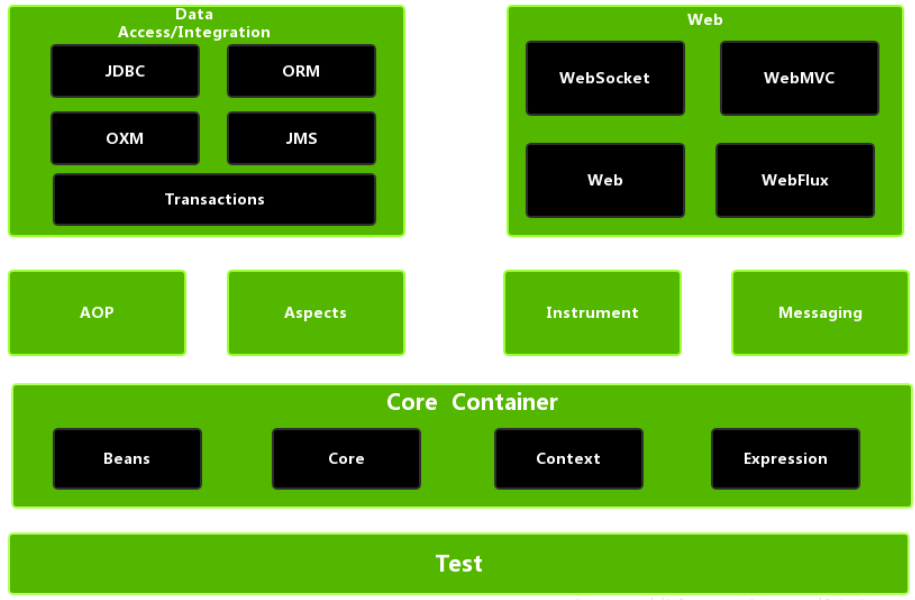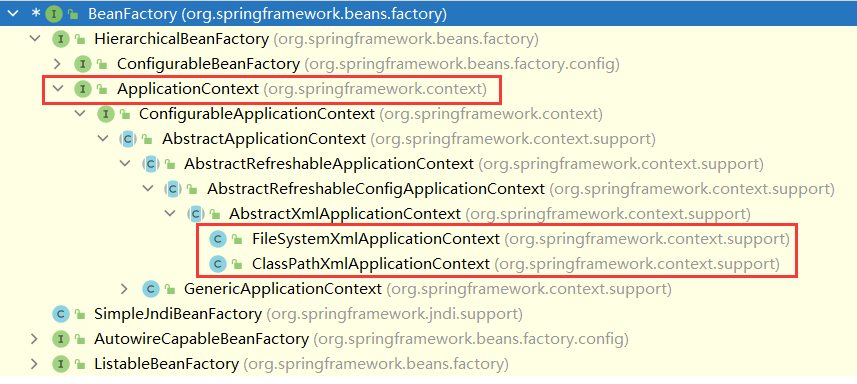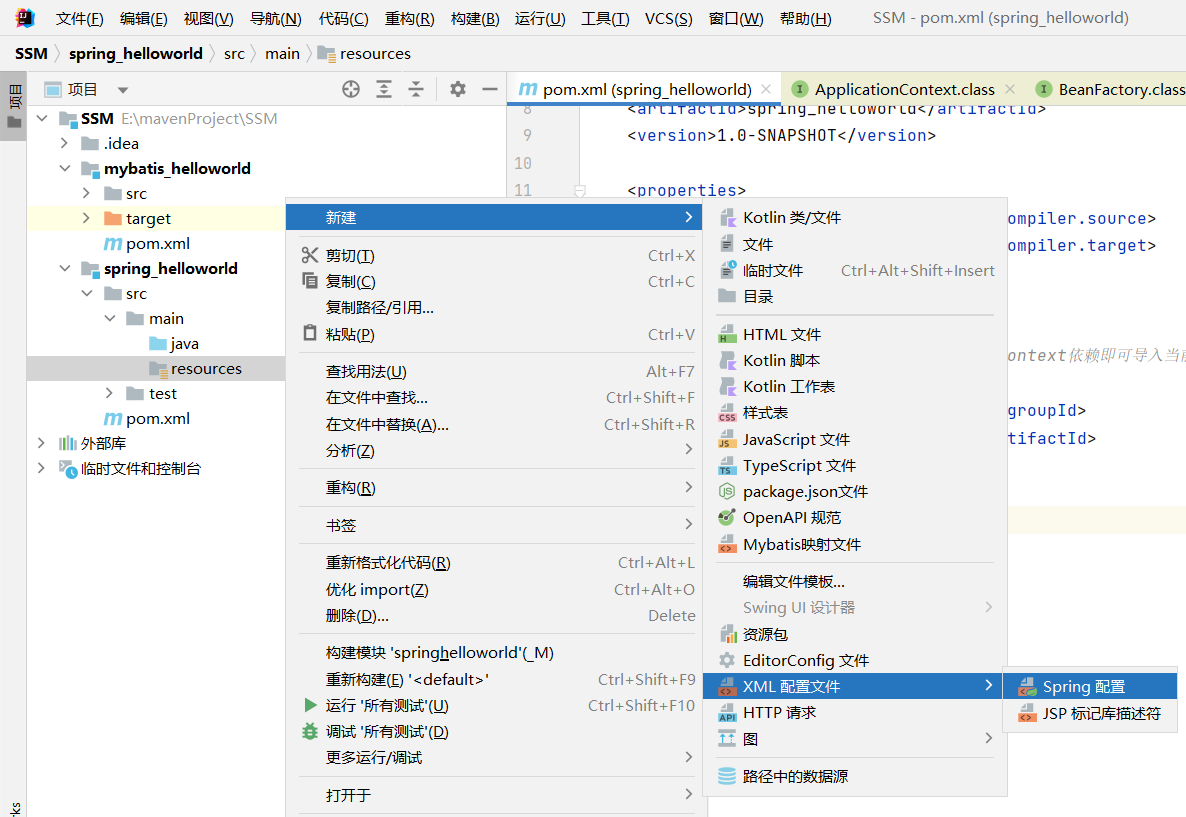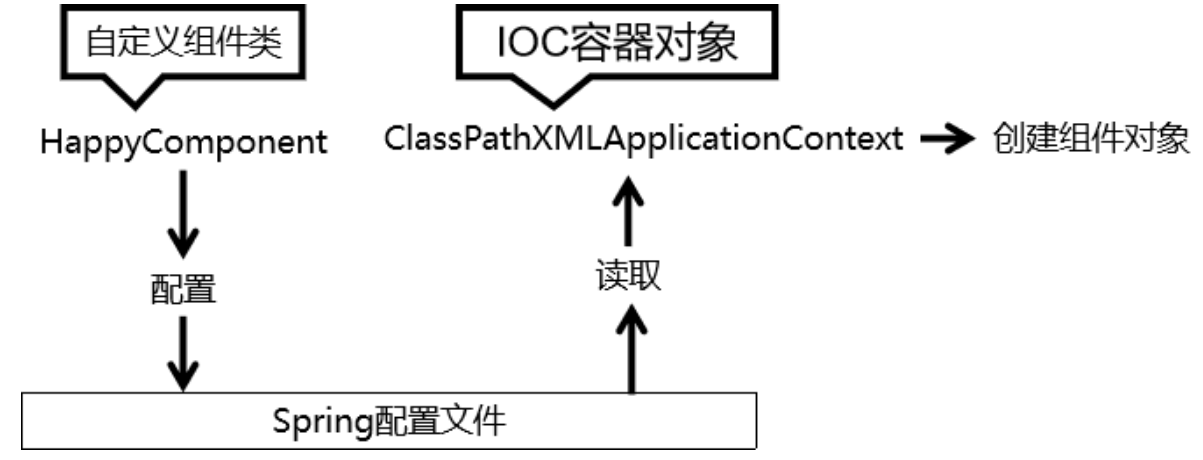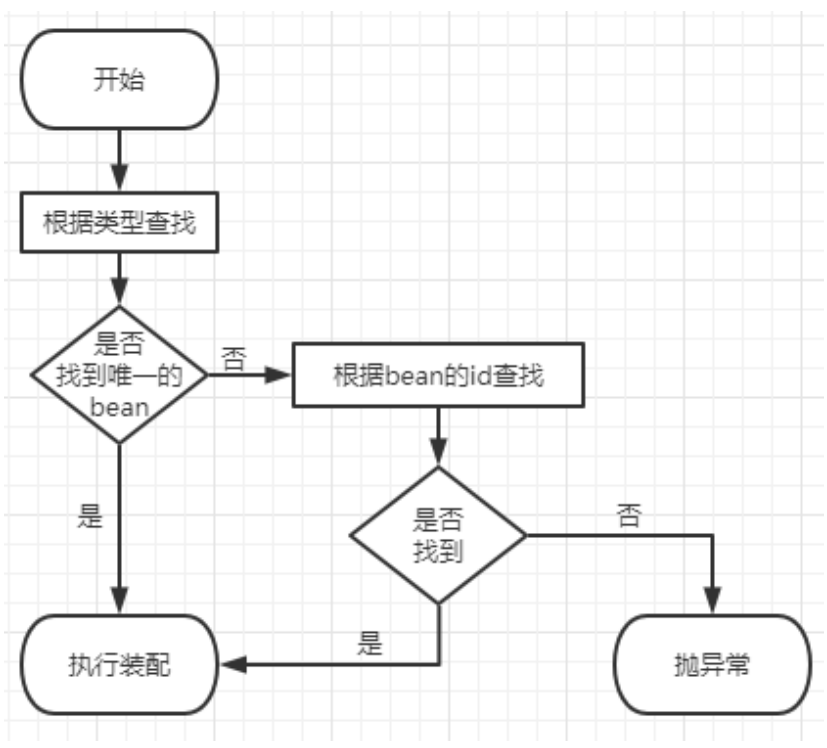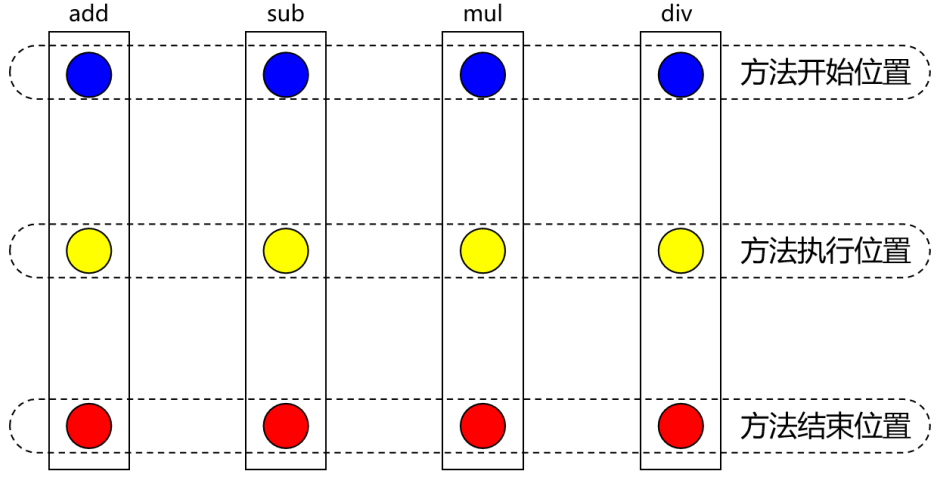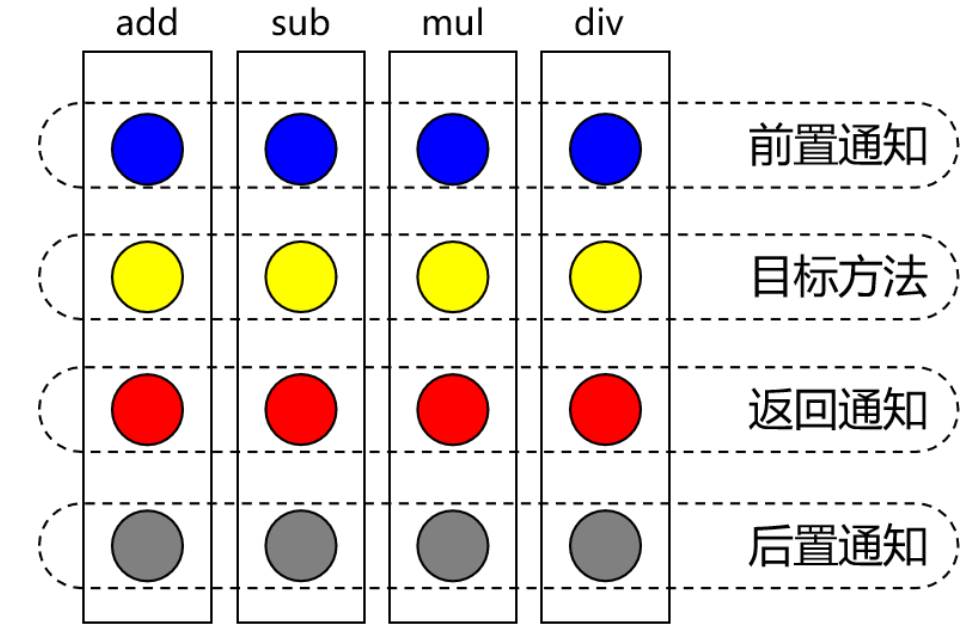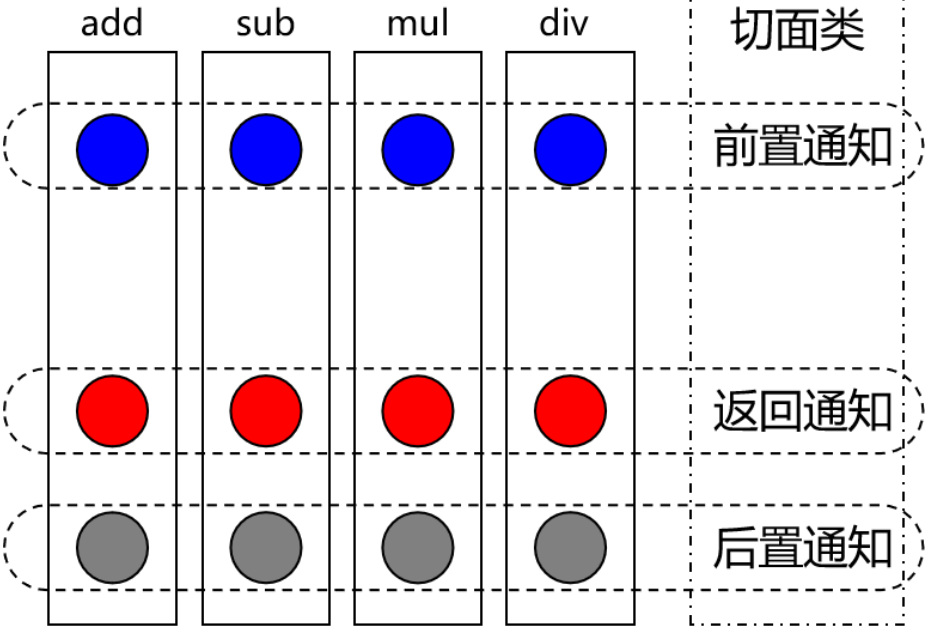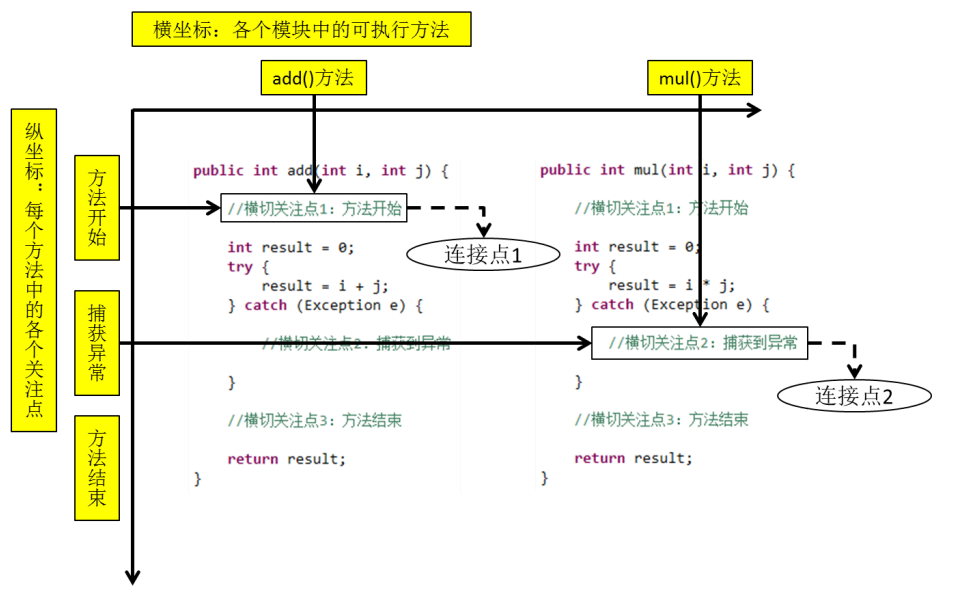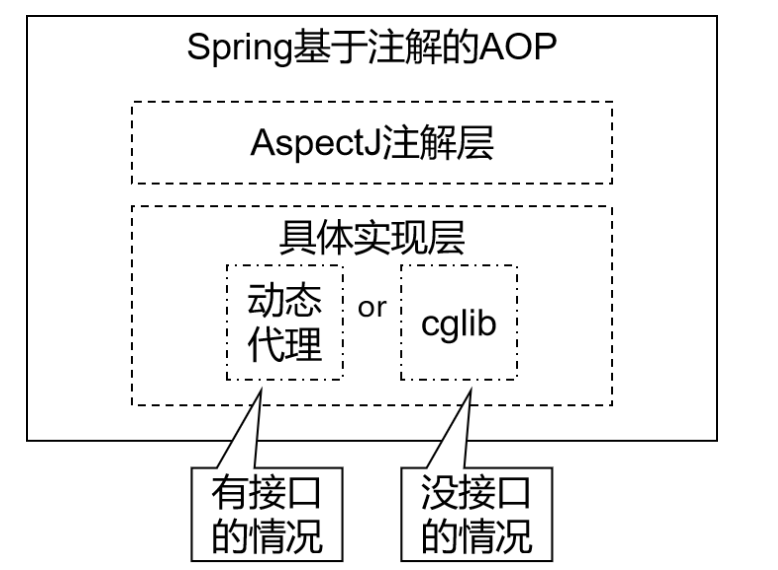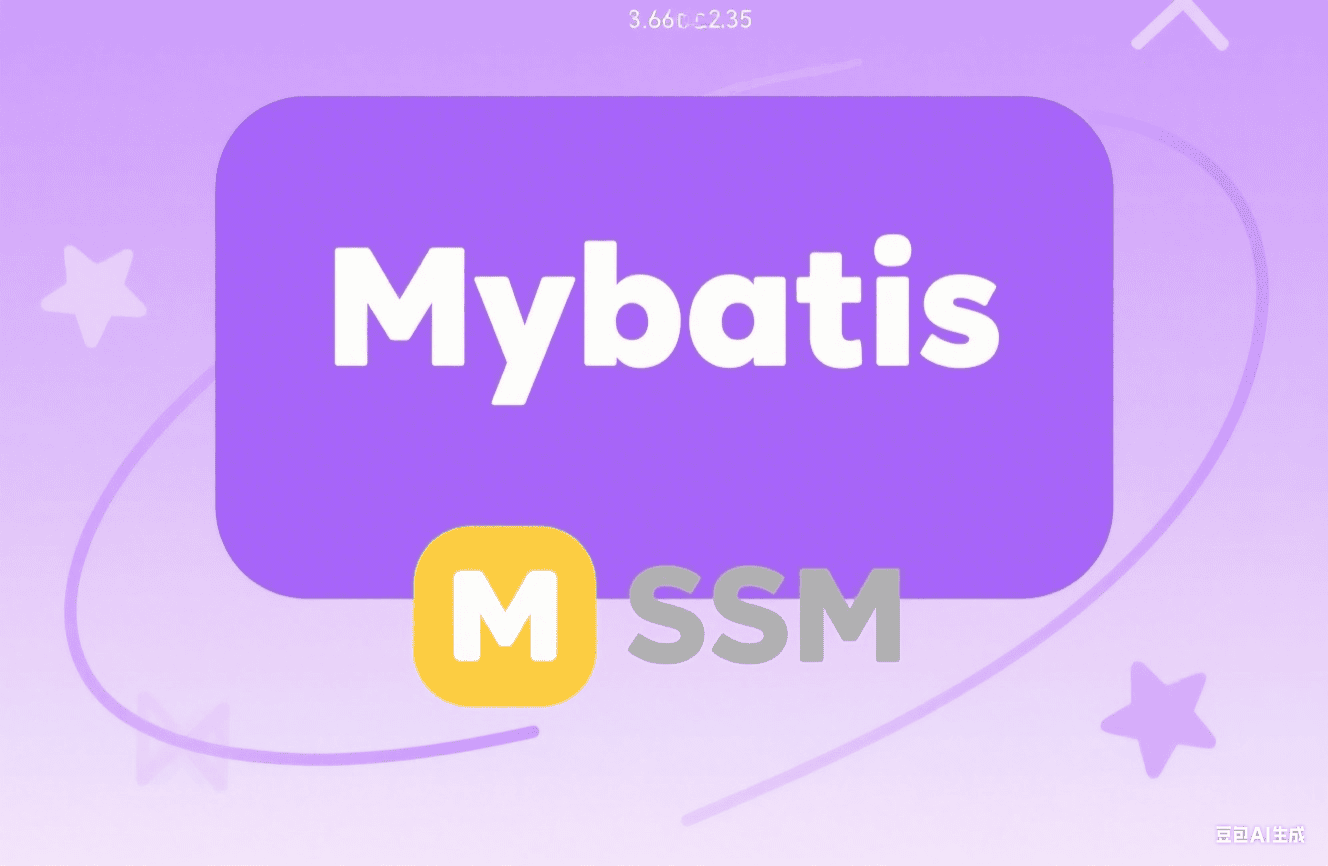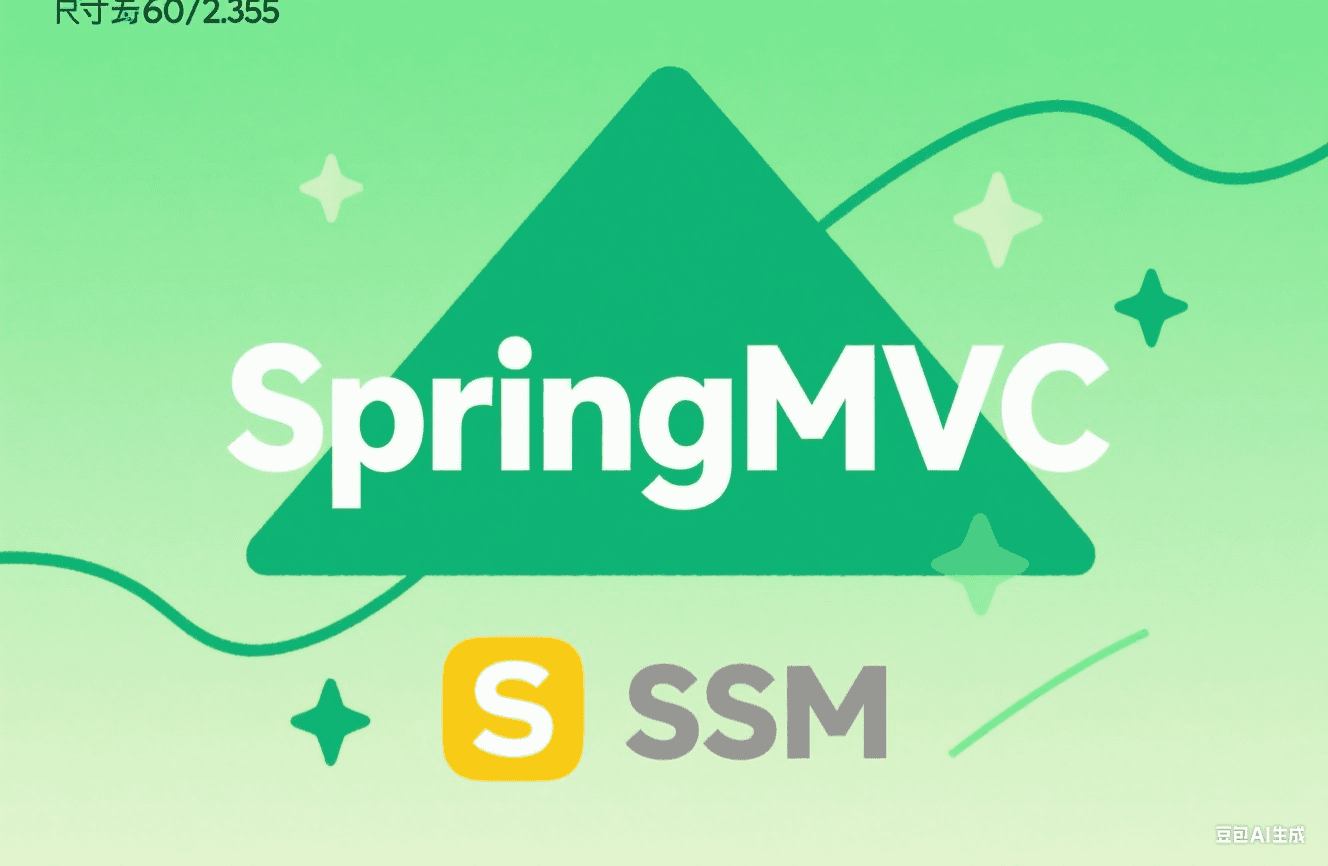Spring简介 Spring概述 Spring 是最受欢迎的企业级 Java 应用程序开发框架,数以百万的来自世界各地的开发人员使用 Spring 框架来创建性能好、易于测试、可重用的代码。
Spring 框架是一个开源的 Java 平台,它最初是由 Rod Johnson 编写的,并且于 2003 年 6 月首 次在 Apache 2.0 许可下发布。
Spring 是轻量级的框架,其基础版本只有 2 MB 左右的大小。
Spring 框架的核心特性是可以用于开发任何 Java 应用程序,但是在 Java EE 平台上构建 web 应 用程序是需要扩展的。 Spring 框架的目标是使 J2EE 开发变得更容易使用,通过启用基于 POJO 编程模型来促进良好的编程实践。
Spring Framework Spring 基础框架,可以视为 Spring 基础设施,基本上任何其他 Spring 项目都是以 Spring Framework为基础的。
Spring Framework特性
非侵入式:使用 Spring Framework 开发应用程序时,Spring 对应用程序本身的结构影响非常 小。对领域模型可以做到零污染;对功能性组件也只需要使用几个简单的注解进行标记,完全不会 破坏原有结构,反而能将组件结构进一步简化。这就使得基于 Spring Framework 开发应用程序 时结构清晰、简洁优雅。
控制反转:IOC——Inversion of Control,翻转资源获取方向。把自己创建资源、向环境索取资源 变成环境将资源准备好,我们享受资源注入。
面向切面编程:AOP——Aspect Oriented Programming,在不修改源代码的基础上增强代码功 能。
容器:Spring IOC 是一个容器,因为它包含并且管理组件对象的生命周期。组件享受到了容器化 的管理,替程序员屏蔽了组件创建过程中的大量细节,极大的降低了使用门槛,大幅度提高了开发 效率。
组件化:Spring 实现了使用简单的组件配置组合成一个复杂的应用。在 Spring 中可以使用 XML 和 Java 注解组合这些对象。这使得我们可以基于一个个功能明确、边界清晰的组件有条不紊的搭建超大型复杂应用系统。
声明式:很多以前需要编写代码才能实现的功能,现在只需要声明需求即可由框架代为实现。
一站式:在 IOC 和 AOP 的基础上可以整合各种企业应用的开源框架和优秀的第三方类库。而且 Spring 旗下的项目已经覆盖了广泛领域,很多方面的功能性需求可以在 Spring Framework 的基 础上全部使用 Spring 来实现。
Spring Framework五大功能模块
功能模块
功能介绍
Core Container
核心容器,在 Spring 环境下使用任何功能都必须基于 IOC 容器。
AOP&Aspects
面向切面编程
Testing
提供了对 junit 或 TestNG 测试框架的整合。
Data Access/Integration
提供了对数据访问/集成的功能。
Spring MVC
提供了面向Web应用程序的集成功能。
IOC IOC容器 IOC思想 IOC:Inversion of Control,翻译过来是反转控制。
获取资源的传统方式
自己做饭:买菜、洗菜、择菜、改刀、炒菜,全过程参与,费时费力,必须清楚了解资源创建整个过程 中的全部细节且熟练掌握。
在应用程序中的组件需要获取资源时,传统的方式是组件主动 的从容器中获取所需要的资源,在这样的模式下开发人员往往需要知道在具体容器中特定资源的获取方式,增加了学习成本,同时降低了开发效率。
反转控制方式获取资源
点外卖:下单、等、吃,省时省力,不必关心资源创建过程的所有细节。
反转控制的思想完全颠覆了应用程序组件获取资源的传统方式:反转了资源的获取方向——改由容器主 动的将资源推送给需要的组件,开发人员不需要知道容器是如何创建资源对象的,只需要提供接收资源 的方式即可,极大的降低了学习成本,提高了开发的效率。这种行为也称为查找的被动 形式。
DI(依赖注入) DI:Dependency Injection,翻译过来是依赖注入。
DI 是 IOC 的另一种表述方式:即组件以一些预先定义好的方式(例如:setter 方法)接受来自于容器的资源注入。相对于IOC而言,这种表述更直接。
所以结论是:IOC就是一种反转控制的思想, 而 DI 是对IOC的一种具体实现 。
IoC和DI的区别 IOC和DI其实是同一概念的不同角度 描述。IoC强调的是将对象实例的创建控制权由spring容器来统一管理,需要的时候从容器中取出 ,而不是由调用者自身去创建,从而达到降低代码耦合性与硬代码的目的。**依赖注入强调的是当调用者需要使用对象实例时,spring容器为调用者提供对象实例这个过程。**本质上应该是属于同一技术实现方式,但是在不同的情况,叫法不同。就好比张三在村里住的时候,邻居叫他狗蛋,但是出到外面打工,别人叫他张三一样。
IOC容器在Spring中的实现 Spring 的 IOC 容器就是 IOC 思想的一个落地的产品实现 。IOC 容器中管理的组件也叫做 bean。在创建 bean 之前,首先需要创建 IOC 容器。
Spring 提供了 IOC 容器的两种实现方式:
类型名
简介
ClassPathXmlApplicationContext
通过读取类路径下的 XML 格式的配置文件创建 IOC 容器 对象
FileSystemXmlApplicationContext
通过文件系统路径读取 XML 格式的配置文件创建 IOC 容 器对象
ConfigurableApplicationContext
ApplicationContext 的子接口,包含一些扩展方法 refresh() 和 close() ,让 ApplicationContext 具有启动、 关闭和刷新上下文的能力。
WebApplicationContext
专门为 Web 应用准备,基于 Web 环境创建 IOC 容器对 象,并将对象引入存入 ServletContext 域中。
基于XML管理Bean Spring的快速入门
创建maven项目
引入依赖
1 2 3 4 5 6 7 8 9 10 11 12 13 14 15 <dependencies > <dependency > <groupId > org.springframework</groupId > <artifactId > spring-context</artifactId > <version > 5.3.1</version > </dependency > <dependency > <groupId > junit</groupId > <artifactId > junit</artifactId > <version > 4.12</version > <scope > test</scope > </dependency > </dependencies >
创建类HelloWorld
1 2 3 4 5 public class HelloWorld { public void sayHello () { System.out.println("helloworld" ); } }
创建Spring的配置文件applicationContext.xml
在spring配置文件中配置bean
1 2 3 4 5 6 7 8 <bean id ="helloworld" class ="com.atguigu.spring.bean.HelloWorld" > </bean >
创建类测试
1 2 3 4 5 6 7 8 9 @Test public void testHelloWorld () { ApplicationContext ac = new ClassPathXmlApplicationContext ("applicationContext.xml" ); HelloWorld helloworld = (HelloWorld) ac.getBean("helloworld" ); helloworld.sayHello(); }
思路
注意:Spring底层默认通过反射技术调用组件类的无参构造器来创建组件对象,这一点需要注意。如果在需要 无参构造器时,没有无参构造器,则会抛出下面的异常。
获取bean的三种方式
注意
当根据类型获取bean时,要求IOC容器中指定类型的bean有且只能有一个 当IOC容器中一共配置了两个:
1 2 <bean id ="helloworldOne" class ="com.atguigu.spring.bean.HelloWorld" > </bean > <bean id ="helloworldTwo" class ="com.atguigu.spring.bean.HelloWorld" > </bean >
根据类型获取时会抛出异常(无法确定获取的是哪一个):
NoUniqueBeanDefinitionException
如果容器中没有bean时抛出异常:
NoSuchBeanDefinitionException
如果组件类实现了接口,根据接口类型可以获取 bean 吗?
可以,前提是bean唯一的。
如果一个接口有多个实现类,这些实现类都配置了 bean,根据接口类型可以获取 bean 吗?
不行,因为bean不唯一
根据类型来获取bean时,在满足bean唯一性 的前提下,其实只是看:『对象 instanceof 指定的类型』的返回结果,只要返回的是true就可以认定为和类型匹配,能够获取到。
依赖注入的两种方式 setter注入
创建学生类Student
1 2 3 4 5 6 7 @Data public class Student { private Integer id; private String name; private Integer age; private String sex; }
配置Bean为属性赋值
1 2 3 4 5 6 7 8 9 <bean id ="studentOne" class ="com.atguigu.spring.bean.Student" > <property name ="id" value ="1001" > </property > <property name ="name" value ="张三" > </property > <property name ="age" value ="23" > </property > <property name ="sex" value ="男" > </property > </bean >
测试
1 2 3 4 5 6 @Test public void testDIBySet () { ApplicationContext ac = new ClassPathXmlApplicationContext ("applicationContext.xml" ); Student studentOne = ac.getBean("studentOne" , Student.class); System.out.println(studentOne); }
构造器注入
在Student类中添加有参构造
1 2 3 4 5 6 7 8 9 @Data @AllArgsConstructor @NoArgsConstructor public class Student { private Integer id; private String name; private Integer age; private String sex; }
配置bean
1 2 3 4 5 6 <bean id ="studentTwo" class ="com.atguigu.spring.bean.Student" > <constructor-arg value ="1002" > </constructor-arg > <constructor-arg value ="李四" > </constructor-arg > <constructor-arg value ="33" > </constructor-arg > <constructor-arg value ="女" > </constructor-arg > </bean >
注意: constructor-arg标签还有两个属性可以进一步描述构造器参数:
index属性:指定参数所在位置的索引(从0开始)
name属性:指定参数名
测试
1 2 3 4 5 6 @Test public void testDIBySet () { ApplicationContext ac = new ClassPathXmlApplicationContext ("applicationContext.xml" ); Student studentOne = ac.getBean("studentTwo" , Student.class); System.out.println(studentOne); }
依赖注入的类型 字面量赋值 1 2 <property name ="name" value ="张三" />
null值 1 2 3 4 5 <property name ="name" > <null /> </property >
xml实体 1 2 3 <property name ="expression" value ="a < b" />
CDATA节 1 2 3 4 5 6 7 <property name ="expression" > <value > <![CDATA[a < b]]></value > </property >
为类属性赋值
创建Clazz类
1 2 3 4 5 6 7 @Data @AllArgsConstructor @NoArgsConstructor public class Clazz { private Integer clazzId; private String clazzName; }
在Student中添加该Clazz类属性
1 2 3 4 5 6 7 8 9 10 @Data @AllArgsConstructor @NoArgsConstructor public class Student { private Integer id; private String name; private Integer age; private String gender; private Clazz clazz; }
配置bean
1 2 3 4 5 6 7 8 9 10 11 12 13 14 15 16 17 18 19 20 21 22 23 24 25 26 27 <bean id ="studentThree" class ="com.atguigu.spring.bean.Student" > <property name ="clazz" ref ="clazz" /> </bean > <bean id ="clazz" class ="com.atguigu.spring.bean.Clazz" > <property name ="clazzId" value ="1" /> <property name ="clazzName" value ="aaa" /> </bean > <bean id ="studentFour" class ="com.atguigu.spring.bean.Student" > <property name ="clazz" > <bean id ="clazzInner" class ="com.atguigu.spring.bean.Clazz" > <property name ="clazzId" value ="2222" > </property > <property name ="clazzName" value ="远大前程班" > </property > </bean > </property > </bean > <bean id ="studentFour" class ="com.atguigu.spring.bean.Student" > <property name ="clazz" ref ="clazzOne" > </property > <property name ="clazz.clazzId" value ="3333" > </property > <property name ="clazz.clazzName" value ="最强王者班" > </property > </bean >
测试
1 2 3 4 5 6 7 @Test public void testStudentThree () { ApplicationContext ioc = new ClassPathXmlApplicationContext ("applicationContext.xml" ); Student studentThree = (Student) ioc.getBean("studentThree" ); System.out.println(studentThree); }
为数组类型属性赋值
在Student中添加属性
配置bean
1 2 3 4 5 6 7 8 9 <bean id ="studentFour" class ="com.atguigu.spring.bean.Student" > <property name ="hobby" > <array > <value > 抽烟</value > <value > 喝酒</value > <value > 烫头</value > </array > </property > </bean >
测试
1 2 3 4 5 6 @Test public void testStudentFour () { ApplicationContext ioc = new ClassPathXmlApplicationContext ("applicationContext.xml" ); Student studentFour = (Student) ioc.getBean("studentFour" ); System.out.println(studentFour); }
为集合类型属性赋值 为list集合属性赋值
在Student中添加属性
配置bean
1 2 3 4 5 6 7 8 9 10 11 12 13 14 15 16 17 18 19 20 21 <bean id ="studentFive" class ="com.atguigu.spring.bean.Student" > <property name ="interest" > <list > <value > 学习</value > <value > 继续学习</value > <value > 还是学习</value > </list > </property > </bean > <bean id ="studentFour" class ="com.atguigu.spring.bean.Student" > <property name ="hobby" ref ="studentList" /> </bean > <util:list id ="studentList" > <value > 抽烟</value > <value > 喝酒</value > <value > 烫头</value > </util:list >
测试
1 2 3 4 5 6 @Test public void testStudentFour () { ApplicationContext ioc = new ClassPathXmlApplicationContext ("applicationContext.xml" ); Student studentFour = (Student) ioc.getBean("studentFour" ); System.out.println(studentFour); }
为Set集合属性赋值 若为Set集合类型属性赋值,只需要将其中的list标签改为set标签即可。
为Map集合属性赋值
在Student中添加属性
配置bean
1 2 3 4 5 6 7 8 9 10 11 12 13 14 15 16 17 18 19 20 21 22 23 24 25 26 27 28 29 <bean id ="studentFriend" class ="com.atguigu.spring.bean.Student" > <property name ="friend" > <map > <entry key ="zhangsan" value ="张三" /> <entry key ="lisi" value ="李四" /> </map > </property > </bean >
测试
1 2 3 4 5 6 @Test public void testStudentFriend () { ApplicationContext ioc = new ClassPathXmlApplicationContext ("applicationContext.xml" ); Student studentFriend = (Student) ioc.getBean("studentFriend" ); System.out.println(studentFriend); }
为properties类型属性赋值 1 2 3 4 5 <property name ="pros" > <props > <prop key ="abc" > fdsa</prop > </props > </property >
p命名空间 引入p命名空间后,可以通过以下方式为bean的各个属性赋值
1 2 <bean id ="studentSix" class ="com.atguigu.spring.bean.Student" p:id ="1006" p:name ="小明" p:clazz-ref ="clazzOne" p:teacherMapref ="teacherMap" ></bean >
引入外部属性文件
加入依赖
1 2 3 4 5 6 7 8 9 10 11 12 <dependency > <groupId > mysql</groupId > <artifactId > mysql-connector-java</artifactId > <version > 8.0.16</version > </dependency > <dependency > <groupId > com.alibaba</groupId > <artifactId > druid</artifactId > <version > 1.0.31</version > </dependency >
创建外部属性文件
1 2 3 4 jdbc.user =root jdbc.password =root jdbc.url =jdbc:mysql://localhost:3306/ssm?serverTimezone=UTC jdbc.driver =com.mysql.cj.jdbc.Driver
引入properties文件和配置bean
1 2 3 4 5 6 7 8 9 <context:property-placeholder location ="jdbc.properties" /> <bean id ="dataSource" class ="com.alibaba.druid.pool.DruidDataSource" > <property name ="username" value ="${jdbc.username}" /> <property name ="password" value ="${jdbc.password}" /> <property name ="url" value ="${jdbc.url}" /> <property name ="driverClassName" value ="${jdbc.driver}" /> </bean >
测试
1 2 3 4 5 6 7 @Test public void testDataSource () throws SQLException { ApplicationContext ac = new ClassPathXmlApplicationContext ("applicationContext.xml" ); DataSource dataSource = ac.getBean(DataSource.class); Connection connection = dataSource.getConnection(); System.out.println(connection); }
作用域 在Spring中可以通过配置bean标签的scope属性来指定bean的作用域范围,各取值含义参加下表:
取值
含义
创建对象的时机
singleton(默认)
在IOC容器中,这个bean创建的对象始终为单例
IOC容器初始化时
prototype
这个bean在IOC容器中有多个实例
获取bean时创建
如果是在WebApplicationContext环境下还会有另外两个作用域(但不常用):
取值
含义
request
在一个请求范围内有效
session
在一个会话范围内有效
bean的生命周期 具体的生命周期过程
bean对象创建(调用无参构造器)
给bean对象设置属性
bean对象初始化之前操作(由bean的后置处理器负责)
bean对象初始化(需在配置bean时指定初始化方法)
bean对象初始化之后操作(由bean的后置处理器负责)
bean对象就绪可以使用
bean对象销毁(需在配置bean时指定销毁方法)
IOC容器关闭
添加User类
1 2 3 4 5 6 7 8 9 10 11 12 13 14 15 16 17 18 19 20 21 22 23 24 25 26 27 28 29 30 31 32 33 34 35 36 37 38 39 40 41 42 43 44 45 46 47 48 49 50 51 52 53 54 55 56 57 58 59 package com.atguigu.spring.bean;public class User { private Integer id; private String username; private String password; private Integer age; public User () { System.out.println("生命周期:1、创建对象" ); } public User (Integer id, String username, String password, Integer age) { this .id = id; this .username = username; this .password = password; this .age = age; } public Integer getId () { return id; } public void setId (Integer id) { System.out.println("生命周期:2、依赖注入" ); this .id = id; } public String getUsername () { return username; } public void setUsername (String username) { this .username = username; } public String getPassword () { return password; } public void setPassword (String password) { this .password = password; } public Integer getAge () { return age; } public void setAge (Integer age) { this .age = age; } public void initMethod () { System.out.println("生命周期:3、初始化" ); } public void destroyMethod () { System.out.println("生命周期:4、销毁" ); } @Override public String toString () { return "User{" + "id=" + id + ", username='" + username + '\'' + ", password='" + password + '\'' + ", age=" + age + '}' ; } }
配置bean
1 2 3 4 5 6 7 8 9 <bean class ="com.atguigu.bean.User" scope ="prototype" init-method ="initMethod" destroy-method ="destroyMethod" > <property name ="id" value ="1001" > </property > <property name ="username" value ="admin" > </property > <property name ="password" value ="123456" > </property > <property name ="age" value ="23" > </property > </bean >
测试
1 2 3 4 5 6 7 8 @Test public void testLife () { ClassPathXmlApplicationContext ac = new ClassPathXmlApplicationContext ("spring-lifecycle.xml" ); User bean = ac.getBean(User.class); System.out.println("生命周期:4、通过IOC容器获取bean并使用" ); ac.close(); }
bean的后置处理器 bean的后置处理器会在生命周期的初始化前后添加额外的操作,需要实现BeanPostProcessor接口, 且配置到IOC容器中,需要注意的是,bean后置处理器不是单独针对某一个bean生效,而是针对IOC容器中所有bean 都会执行。
创建后置处理器
1 2 3 4 5 6 7 8 9 10 11 12 13 14 15 16 17 package com.atguigu.spring.process;import org.springframework.beans.BeansException;import org.springframework.beans.factory.config.BeanPostProcessor;public class MyBeanProcessor implements BeanPostProcessor { @Override public Object postProcessBeforeInitialization (Object bean, String beanName) throws BeansException { System.out.println("☆☆☆" + beanName + " = " + bean); return bean; } @Override public Object postProcessAfterInitialization (Object bean, String beanName) throws BeansException { System.out.println("★★★" + beanName + " = " + bean); return bean; } }
在IOC容器中配置后置处理器:
1 2 <bean id ="myBeanProcessor" class ="com.atguigu.spring.process.MyBeanProcessor" />
FactoryBean FactoryBean是Spring提供的一种整合第三方框架的常用机制。和普通的bean不同,配置一个 FactoryBean类型的bean,在获取bean的时候得到的并不是class属性中配置的这个类的对象,而是 getObject()方法的返回值 。通过这种机制,Spring可以帮我们把复杂组件创建的详细过程和繁琐细节都 屏蔽起来,只把最简洁的使用界面展示给我们。整合Mybatis时,Spring就是通过FactoryBean机制来帮我们创建SqlSessionFactory对象的。
当把FactoryBean的实现类配置为bean时,会将当前类中getObject()所返回的对象交给IOC容器管理。
创建类UserFactoryBean
1 2 3 4 5 6 7 8 9 10 public class UserFactoryBean implements FactoryBean <User> { @Override public User getObject () throws Exception { return new User (); } @Override public Class<?> getObjectType() { return User.class; } }
配置bean
1 <bean id ="user" class ="com.atguigu.bean.UserFactoryBean" > </bean >
测试
1 2 3 4 5 6 7 @Test public void testUserFactoryBean () { ApplicationContext ac = new ClassPathXmlApplicationContext ("springfactorybean.xml" ); User user = (User) ac.getBean("user" ); System.out.println(user); }
基于xml的自动装配 根据指定的策略,在IOC容器中匹配某一个bean,自动为指定的bean中所依赖的类类型或接口类型属性赋值。
使用bean标签的autowire属性设置自动装配策略。
自动装配方式:byType
byType:根据要赋值的属性的类型,在IOC容器中匹配某个bean为属性赋值。
若在IOC中,没有任何一个兼容类型的bean能够为属性赋值,则该属性不装配,即值为默认值 null。
若在IOC中,有多个兼容类型的bean能够为属性赋值,则抛出异常 NoUniqueBeanDefinitionException
1 2 3 4 5 6 <bean id ="userController" class ="com.atguigu.autowire.xml.controller.UserController" autowire ="byType" > </bean > <bean id ="userService" class ="com.atguigu.autowire.xml.service.impl.UserServiceImpl" autowire ="byType" > </bean > <bean id ="userDao" class ="com.atguigu.autowire.xml.dao.impl.UserDaoImpl" > </bean >
1 2 3 4 5 6 7 8 9 10 11 12 13 <bean id ="userController" class ="com.atguigu.autowire.xml.controller.UserController" autowire ="byName" > </bean > <bean id ="userService" class ="com.atguigu.autowire.xml.service.impl.UserServiceImpl" autowire ="byName" > </bean > <bean id ="userDao" class ="com.atguigu.autowire.xml.dao.impl.UserDaoImpl" > </bean > <bean id ="userServiceImpl" class ="com.atguigu.autowire.xml.service.impl.UserServiceImpl" autowire ="byName" > </bean > <bean id ="userDaoImpl" class ="com.atguigu.autowire.xml.dao.impl.UserDaoImpl" > </bean >
自动装配的策略
no,default:表示不装配,即bean中的属性不会自动匹配某个bean为属性赋值,此属性使用默认值。
基于注解管理Bean 标记 和 XML 配置文件一样,注解本身并不能执行,注解本身仅仅只是做一个标记,具体的功能是框架检测 到注解标记的位置,然后针对这个位置按照注解标记的功能来执行具体操作。
本质上:所有一切的操作都是Java代码来完成的,XML和注解只是告诉框架中的Java代码如何执行。
扫描 Spring 为了知道程序员在哪些地方标记了什么注解,就需要通过扫描的方式,来进行检测。然后根据注 解进行后续操作。
常用注解
注解
作用
@Component
将类标识为普通组件
@Controller
将类标识为控制层组件(Controller)
@Service
将类标识为业务层组件(Service)
@Repository
将类标识为持久层组件(Dao)
问:以上四个注解有什么关系和区别?
@Controller、@Service、@Repository这三个注解只是在@Component注解 的基础上起了三个新的名字。
对于Spring使用IOC容器管理这些组件来说没有区别。所以@Controller、@Service、@Repository这 三个注解只是给开发人员看的,让我们能够便于分辨组件的作用。
注意 :虽然它们本质上一样,但是为了代码的可读性,为了程序结构严谨我们肯定不能随便胡乱标记。
创建组件 创建控制层组件 1 2 3 @Controller public class UserController {}
创建业务层组件 1 2 3 @Service public class UserServiceImpl implements UserService {}
创建持久层组件 1 2 3 @Repository public class UserDaoImpl implements UserDao {}
扫描组件 情况一:最基本的扫描方式
1 <context:component-scan base-package ="com.atguigu" > </context:component-scan >
情况二:指定要排除的组件
1 2 3 4 5 6 7 8 9 10 11 12 13 14 <context:component-scan base-package ="com.atguigu" > <context:exclude-filter type ="annotation" expression ="org.springframework.stereotype.Controller" /> </context:component-scan >
情况三:仅扫描指定组件
1 2 3 4 5 6 7 8 9 10 11 12 13 14 <context:component-scan base-package ="com.atguigu" use-default-filters ="false" > <context:include-filter type ="annotation" expression ="org.springframework.stereotype.Controller" /> </context:component-scan >
组件所对应的bean的id
默认情况
类名首字母小写就是bean的id。例如:UserController类对应的bean的id就是userController。
自定义bean的id
可通过标识组件的注解的value属性设置自定义的bean的id @Service(“userService”)// 默认为userServiceImpl public class UserServiceImpl implements UserService {}
基于注解的自动装配 @Autowired注解 在成员变量上直接标记@Autowired注解即可完成自动装配,不需要提供setXxx()方法。以后我们在项目中的正式用法就是这样。
1 2 3 4 5 6 7 8 @Controller public class UserController { @Autowired private UserService userService; public void saveUser () { userService.saveUser(); } }
1 2 3 public interface UserService { void saveUser () ; }
1 2 3 4 5 6 7 8 9 @Service public class UserServiceImpl implements UserService { @Autowired private UserDao userDao; @Override public void saveUser () { userDao.saveUser(); } }
1 2 3 public interface UserDao { void saveUser () ; }
1 2 3 4 5 6 7 @Repository public class UserDaoImpl implements UserDao { @Override public void saveUser () { System.out.println("保存成功" ); } }
@Autowired注解其他细节
@Autowired注解可以标记在构造器和set方法上
1 2 3 4 5 6 7 8 @Autowired public UserController (UserService userService) { this .userService = userService; }
@Autowired的工作流程
@Qualifier():和@Autowired连用,通过该注解的value属性值,指定某个bean的id,将这个bean为属性赋值。
AOP 代理模式之场景模拟
声明接口
1 2 3 4 5 6 public interface Calculator { int add (int i, int j) ; int sub (int i, int j) ; int mul (int i, int j) ; int div (int i, int j) ; }
创建实现类
1 2 3 4 5 6 7 8 9 10 11 12 13 14 15 16 17 18 19 20 21 22 23 24 25 26 27 28 29 public class CalculatorPureImpl implements Calculator { @Override public int add (int i, int j) { int result = i + j; System.out.println("方法内部 result = " + result); return result; } @Override public int sub (int i, int j) { int result = i - j; System.out.println("方法内部 result = " + result); return result; } @Override public int mul (int i, int j) { int result = i * j; System.out.println("方法内部 result = " + result); return result; } @Override public int div (int i, int j) { int result = i / j; System.out.println("方法内部 result = " + result); return result; } }
创建带日志功能的实现类
1 2 3 4 5 6 7 8 9 10 11 12 13 14 15 16 17 18 19 20 21 22 23 24 25 26 27 28 29 30 31 32 33 34 public class CalculatorLogImpl implements Calculator { @Override public int add (int i, int j) { System.out.println("[日志] add 方法开始了,参数是:" + i + "," + j); int result = i + j; System.out.println("方法内部 result = " + result); System.out.println("[日志] add 方法结束了,结果是:" + result); return result; } @Override public int sub (int i, int j) { System.out.println("[日志] sub 方法开始了,参数是:" + i + "," + j); int result = i - j; System.out.println("方法内部 result = " + result); System.out.println("[日志] sub 方法结束了,结果是:" + result); return result; } @Override public int mul (int i, int j) { System.out.println("[日志] mul 方法开始了,参数是:" + i + "," + j); int result = i * j; System.out.println("方法内部 result = " + result); System.out.println("[日志] mul 方法结束了,结果是:" + result); return result; } @Override public int div (int i, int j) { System.out.println("[日志] div 方法开始了,参数是:" + i + "," + j); int result = i / j; System.out.println("方法内部 result = " + result); System.out.println("[日志] div 方法结束了,结果是:" + result); return result; } }
提出问题
代理模式 概念 二十三种设计模式中的一种,属于结构型模式。它的作用就是通过提供一个代理类,让我们在调用目标方法的时候,不再是直接对目标方法进行调用,而是通过代理类间接 调用。让不属于目标方法核心逻辑的代码从目标方法中剥离出来——解耦 。调用目标方法时先调用代理对象的方法,减少对目标方法的调 用和打扰,同时让附加功能能够集中在一起也有利于统一维护。
相关术语
代理:将非核心逻辑剥离出来以后,封装这些非核心逻辑的类、对象、方法。
目标:被代理“套用”了非核心逻辑代码的类、对象、方法。
静态代理 创建静态代理类:
1 2 3 4 5 6 7 8 9 10 11 12 13 14 15 16 17 18 public class CalculatorStaticProxy implements Calculator { private Calculator target; public CalculatorStaticProxy (Calculator target) { this .target = target; } @Override public int add (int i, int j) { System.out.println("[日志] add 方法开始了,参数是:" + i + "," + j); int addResult = target.add(i, j); System.out.println("[日志] add 方法结束了,结果是:" + addResult); return addResult; } }
静态代理确实实现了解耦,但是由于代码都写死了,完全不具备任何的灵活性。就拿日志功能来 说,将来其他地方也需要附加日志,那还得再声明更多个静态代理类,那就产生了大量重复的代 码,日志功能还是分散的,没有统一管理。
提出进一步的需求:将日志功能集中到一个代理类中,将来有任何日志需求,都通过这一个代理类来实现。这就需要使用动态代理技术了。
动态代理 生产代理对象的工厂类:
1 2 3 4 5 6 7 8 9 10 11 12 13 14 15 16 17 18 19 20 21 22 23 24 25 26 public class ProxyFactory { private Object target; public ProxyFactory (Object target) { this .target = target; } public Object getProxy () { ClassLoader classLoader = this .getClass().getClassLoader(); Class<?>[] interfaces = target.getClass().getInterfaces(); InvocationHandler invocationHandler = (proxy, method, args) -> { System.out.println("[日志] " +method.getName()+" 方法开始了,参数是:" + Arrays.toString(args)); Object result = method.invoke(target, args); System.out.println("[日志] " +method.getName()+" 方法结束了,结果是:" + result); return result; }; return Proxy.newProxyInstance(classLoader, interfaces,invocationHandler); } }
测试:
1 2 3 4 5 6 @Test public void testProxyTest () { ProxyFactory proxyFactory = new ProxyFactory (new CalculatorImpl ()); Calculator proxy = (Calculator) proxyFactory.getProxy(); proxy.add(1 ,2 ); }
AOP概念及相关术语 概述 AOP(Aspect Oriented Programming)是一种设计思想,是软件设计领域中的面向切面编程,它是面向对象编程的一种补充和完善,它以通过预编译方式和运行期动态代理方式实现在不修改源代码的情况 下给程序动态统一添加额外功能的一种技术。
相关术语 横切关注点 从每个方法中抽取出来的同一类非核心业务 。在同一个项目中,我们可以使用多个横切关注点对相关方法进行多个不同方面的增强。
这个概念不是语法层面天然存在的,而是根据附加功能的逻辑上的需要:有十个附加功能,就有十个横切关注点。
通知 每一个横切关注点上要做的事情都需要写一个方法来实现,这样的方法就叫通知方法。
前置通知:在被代理的目标方法前执行
返回通知:在被代理的目标方法成功结束后执行(寿终正寝)。
异常通知:在被代理的目标方法异常结束后执行(死于非命)。
后置通知:在被代理的目标方法最终结束后执行(盖棺定论)。
环绕通知:使用try…catch…finally结构围绕整个被代理的目标方法,包括上面四种通知对应的所有位置。
切面 封装通知方法的类。
目标 被代理的目标对象。
代理 向目标对象应用通知之后创建的代理对象。
连接点 这也是一个纯逻辑概念 ,不是语法定义的。
把目标方法排成一排,每一个横切位置看成x轴方向,把方法从上到下执行的顺序看成y轴,x轴和y轴的交叉 点就是连接点。
切入点 定位连接点的方式。
个人理解:
可以理解成连接点是逻辑层面的概念,无法通过代码实现。而切入点是可以从代码层面表示连接点的位置。
每个类的方法中都包含多个连接点,所以连接点是类中客观存在的事物(从逻辑上来说)。
Spring 的 AOP 技术可以通过切入点定位到特定的连接点。
切点通过 org.springframework.aop.Pointcut 接口进行描述,它使用类和方法作为连接点的查询条件。
抽横切关注点 封装到切面 中,就是一个个通知 ,通过切入点 可以定位到它的连接点 。
作用
简化代码:把方法中固定位置的重复的代码抽取 出来,让被抽取的方法更专注于自己的核心功能, 提高内聚性。
代码增强:把特定的功能封装到切面类中,看哪里有需要,就往上套,被套用 了切面逻辑的方法就 被切面给增强了。
基于注解的AOP 技术说明
动态代理(InvocationHandler):JDK原生的实现方式,需要被代理的目标类必须实现接口。因 为这个技术要求代理对象和目标对象实现同样的接口(兄弟两个拜把子模式)。
cglib:通过继承被代理的目标类(认干爹模式)实现代理,所以不需要目标类实现接口。
AspectJ:本质上是静态代理,将代理逻辑“织入”被代理的目标类编译得到的字节码文件,所以最 终效果是动态的。weaver就是织入器 。Spring只是借用了AspectJ中的注解。
准备工作 ①添加依赖 在IOC所需依赖基础上再加入下面依赖即可:
1 2 3 4 5 6 <dependency > <groupId > org.springframework</groupId > <artifactId > spring-aspects</artifactId > <version > 5.3.1</version > </dependency >
②准备被代理的目标资源 1 2 3 4 5 6 public interface Calculator { int add (int i, int j) ; int sub (int i, int j) ; int mul (int i, int j) ; int div (int i, int j) ; }
实现类:
1 2 3 4 5 6 7 8 9 10 11 12 13 14 15 16 17 18 19 20 21 22 23 24 25 26 27 @Component public class CalculatorPureImpl implements Calculator { @Override public int add (int i, int j) { int result = i + j; System.out.println("方法内部 result = " + result); return result; } @Override public int sub (int i, int j) { int result = i - j; System.out.println("方法内部 result = " + result); return result; } @Override public int mul (int i, int j) { int result = i * j; System.out.println("方法内部 result = " + result); return result; } @Override public int div (int i, int j) { int result = i / j; System.out.println("方法内部 result = " + result); return result; } }
③创建切面类并配置 1 2 3 4 5 6 7 8 9 10 11 12 13 14 15 16 17 18 19 20 21 22 23 24 25 26 27 28 29 30 31 32 33 34 35 36 37 38 39 40 41 42 43 44 45 46 47 48 49 @Aspect @Component public class LogAspect { @Before("execution(public int com.atguigu.aop.annotation.CalculatorImpl.*(..))") public void beforeMethod (JoinPoint joinPoint) { String methodName = joinPoint.getSignature().getName(); String args = Arrays.toString(joinPoint.getArgs()); System.out.println("Logger-->前置通知,方法名:" +methodName+",参数:" +args); } @After("execution(* com.atguigu.aop.annotation.CalculatorImpl.*(..))") public void afterMethod (JoinPoint joinPoint) { String methodName = joinPoint.getSignature().getName(); System.out.println("Logger-->后置通知,方法名:" +methodName); } @AfterReturning(value = "execution(*com.atguigu.aop.annotation.CalculatorImpl.*(..))", returning = "result") public void afterReturningMethod (JoinPoint joinPoint, Object result) { String methodName = joinPoint.getSignature().getName(); System.out.println("Logger-->返回通知,方法名:" +methodName+",结果:" +result); } @AfterThrowing(value = "execution(*com.atguigu.aop.annotation.CalculatorImpl.*(..))", throwing = "ex") public void afterThrowingMethod (JoinPoint joinPoint, Throwable ex) { String methodName = joinPoint.getSignature().getName(); System.out.println("Logger-->异常通知,方法名:" +methodName+",异常:" +ex); } @Around("execution(* com.atguigu.aop.annotation.CalculatorImpl.*(..))") public Object aroundMethod (ProceedingJoinPoint joinPoint) { String methodName = joinPoint.getSignature().getName(); String args = Arrays.toString(joinPoint.getArgs()); Object result = null ; try { System.out.println("环绕通知-->目标对象方法执行之前" ); result = joinPoint.proceed(); System.out.println("环绕通知-->目标对象方法返回值之后" ); } catch (Throwable throwable) { throwable.printStackTrace(); System.out.println("环绕通知-->目标对象方法出现异常时" ); } finally { System.out.println("环绕通知-->目标对象方法执行完毕" ); } return result; } }
1 2 3 4 <context:component-scan base-package ="com.atguigu.spring.proxy" /> <aop:aspectj-autoproxy />
各种通知
前置通知:使用@Before注解标识,在被代理的目标方法前 执行
返回通知:使用@AfterReturning注解标识,在被代理的目标方法成功结束 后执行(寿终正寝)
异常通知:使用@AfterThrowing注解标识,在被代理的目标方法异常结束 后执行(死于非命)
后置通知:使用@After注解标识,在被代理的目标方法最终结束 后执行(盖棺定论)
环绕通知:使用@Around注解标识,使用try…catch…finally结构围绕整个 被代理的目标方法,包 括上面四种通知对应的所有位置
各种通知的执行顺序:
Spring版本5.3.x以前:
Spring版本5.3.x以后:
切入点表达式语法
用*号代替“权限修饰符”和“返回值”部分表示“权限修饰符”和“返回值”不限。
在方法返回值部分,如果想要明确指定一个返回值类型,那么必须同时写明权限修饰符。
例如:execution(public int ..Service.*(.., int)) 正确
例如:execution(* int ..Service.*(.., int)) 错误
在包名的部分,一个*号只能代表包的层次结构中的一层,表示这一层是任意的。
例如:*.Hello匹配com.Hello,不匹配com.atguigu.Hello。
在包名的部分,使用*..表示包名任意、包的层次深度任意。
在类名的部分,类名部分整体用*号代替,表示类名任意。
在类名的部分,可以使用*号代替类名的一部分。
例如:*Service匹配所有名称以Service结尾的类或接口。
在方法名部分,可以使用*号表示方法名任意。
在方法名部分,可以使用*号代替方法名的一部分。
例如:*Operation匹配所有方法名以Operation结尾的方法。
在方法参数列表部分,使用(int,..)表示参数列表以一个int类型的参数开头。
在方法参数列表部分,基本数据类型和对应的包装类型是不一样的。
切入点表达式中使用 int 和实际方法中 Integer 是不匹配的。
1 通知类型("execution(权限修饰符 返回值 包名.类名.方法名(参数列表))")
重用切入点表达式 ①声明
1 2 @Pointcut("execution(* com.atguigu.aop.annotation.*.*(..))") public void pointCut () {}
②在同一个切面中使用
1 2 3 4 5 6 @Before("pointCut()") public void beforeMethod (JoinPoint joinPoint) { String methodName = joinPoint.getSignature().getName(); String args = Arrays.toString(joinPoint.getArgs()); System.out.println("Logger-->前置通知,方法名:" +methodName+",参数:" +args); }
③在不同切面中使用
1 2 3 4 5 6 @Before("com.atguigu.aop.CommonPointCut.pointCut()") public void beforeMethod (JoinPoint joinPoint) { String methodName = joinPoint.getSignature().getName(); String args = Arrays.toString(joinPoint.getArgs()); System.out.println("Logger-->前置通知,方法名:" +methodName+",参数:" +args); }
获取通知的相关信息 获取连接点信息 获取连接点信息可以在通知方法的参数位置设置JoinPoint类型的形参。
1 2 3 4 5 6 7 8 @Before("execution(public int com.atguigu.aop.annotation.CalculatorImpl.*(..))") public void beforeMethod (JoinPoint joinPoint) { String methodName = joinPoint.getSignature().getName(); String args = Arrays.toString(joinPoint.getArgs()); System.out.println("Logger-->前置通知,方法名:" +methodName+",参数:" +args); }
获取目标方法的返回值 @AfterReturning中的属性returning,用来将通知方法的某个形参,接收目标方法的返回值。
1 2 3 4 5 @AfterReturning(value = "execution(* com.atguigu.aop.annotation.CalculatorImpl.*(..))", returning = "result") public void afterReturningMethod (JoinPoint joinPoint, Object result) { String methodName = joinPoint.getSignature().getName(); System.out.println("Logger-->返回通知,方法名:" +methodName+",结果:" +result); }
获取目标方法的异常 @AfterThrowing中的属性throwing,用来将通知方法的某个形参,接收目标方法的异常
1 2 3 4 5 @AfterThrowing(value = "execution(* com.atguigu.aop.annotation.CalculatorImpl.*(..))", throwing = "ex") public void afterThrowingMethod (JoinPoint joinPoint, Throwable ex) { String methodName = joinPoint.getSignature().getName(); System.out.println("Logger-->异常通知,方法名:" +methodName+",异常:" +ex); }
环绕通知 1 2 3 4 5 6 7 8 9 10 11 12 13 14 15 16 17 18 @Around("execution(* com.atguigu.aop.annotation.CalculatorImpl.*(..))") public Object aroundMethod (ProceedingJoinPoint joinPoint) { String methodName = joinPoint.getSignature().getName(); String args = Arrays.toString(joinPoint.getArgs()); Object result = null ; try { System.out.println("环绕通知-->目标对象方法执行之前" ); result = joinPoint.proceed(); System.out.println("环绕通知-->目标对象方法返回值之后" ); } catch (Throwable throwable) { throwable.printStackTrace(); System.out.println("环绕通知-->目标对象方法出现异常时" ); } finally { System.out.println("环绕通知-->目标对象方法执行完毕" ); } return result; }
切面的优先级 相同目标方法上同时存在多个切面时,切面的优先级控制切面的内外嵌套顺序。
使用@Order注解可以控制切面的优先级:
@Order(较小的数):优先级高。
@Order(较大的数):优先级低。
基于xml的AOP 1 2 3 4 5 6 7 8 9 10 11 12 13 14 15 16 17 18 <context:component-scan base-package ="com.atguigu.aop.xml" > </context:componentscan > <aop:config > <aop:aspect ref ="loggerAspect" > <aop:pointcut id ="pointCut" expression ="execution(* com.atguigu.aop.xml.CalculatorImpl.*(..))" /> <aop:before method ="beforeMethod" pointcut-ref ="pointCut" > </aop:before > <aop:after method ="afterMethod" pointcut-ref ="pointCut" > </aop:after > <aop:after-returning method ="afterReturningMethod" returning ="result" pointcut-ref ="pointCut" > </aop:after-returning > <aop:after-throwing method ="afterThrowingMethod" throwing ="ex" pointcutref ="pointCut" > </aop:after-throwing > <aop:around method ="aroundMethod" pointcut-ref ="pointCut" > </aop:around > </aop:aspect > <aop:aspect ref ="validateAspect" order ="1" > <aop:before method ="validateBeforeMethod" pointcut-ref ="pointCut" > </aop:before > </aop:aspect > </aop:config >
声明式事务 JdbcTemplate 简介 Spring 框架对 JDBC 进行封装,使用 JdbcTemplate 方便实现对数据库操作
准备工作
加入依赖
1 2 3 4 5 6 7 8 9 10 11 12 13 14 15 16 17 18 19 20 21 22 23 24 25 26 27 28 29 30 31 32 33 34 35 36 37 38 39 40 41 <dependencies > <dependency > <groupId > org.springframework</groupId > <artifactId > spring-context</artifactId > <version > 5.3.1</version > </dependency > <dependency > <groupId > org.springframework</groupId > <artifactId > spring-orm</artifactId > <version > 5.3.1</version > </dependency > <dependency > <groupId > org.springframework</groupId > <artifactId > spring-test</artifactId > <version > 5.3.1</version > </dependency > <dependency > <groupId > junit</groupId > <artifactId > junit</artifactId > <version > 4.12</version > <scope > test</scope > </dependency > <dependency > <groupId > mysql</groupId > <artifactId > mysql-connector-java</artifactId > <version > 8.0.16</version > </dependency > <dependency > <groupId > com.alibaba</groupId > <artifactId > druid</artifactId > <version > 1.0.31</version > </dependency > </dependencies >
创建jdbc.properties
1 2 3 4 jdbc.driver =com.mysql.cj.jdbc.Driver jdbc.url =jdbc:mysql://localhost:3306/ssm?serverTimezone=UTC jdbc.username =root jdbc.password =root
配置Spring
1 2 3 4 5 6 7 8 9 10 11 12 13 14 <context:property-placeholder location ="classpath:jdbc.properties" /> <bean id ="druidDataSource" class ="com.alibaba.druid.pool.DruidDataSource" > <property name ="url" value ="${jdbc.url}" /> <property name ="driverClassName" value ="${jdbc.driver}" /> <property name ="username" value ="${jdbc.username}" /> <property name ="password" value ="${jdbc.password}" /> </bean > <bean id ="jdbcTemplate" class ="org.springframework.jdbc.core.JdbcTemplate" > <property name ="dataSource" ref ="druidDataSource" /> </bean >
测试 1 2 3 4 5 6 7 8 @RunWith(SpringJUnit4ClassRunner.class) @ContextConfiguration("classpath:spring-jdbc.xml") public class JDBCTemplateTest { @Autowired private JdbcTemplate jdbcTemplate; }
测试增删改功能
1 2 3 4 5 6 7 @Test public void testUpdate () { String sql = "insert into t_emp values(null,?,?,?)" ; int result = jdbcTemplate.update(sql, "张三" , 23 , "男" ); System.out.println(result); }
查询一条数据为实体类对象
1 2 3 4 5 6 7 @Test public void testSelectEmpById () { String sql = "select * from t_emp where id = ?" ; Emp emp = jdbcTemplate.queryForObject(sql, new BeanPropertyRowMapper <>(Emp.class), 1 ); System.out.println(emp); }
查询多条数据为一个list集合
1 2 3 4 5 6 7 8 @Test public void testSelectList () { String sql = "select * from t_emp" ; List<Emp> list = jdbcTemplate.query(sql, new BeanPropertyRowMapper <>(Emp.class)); list.forEach(emp -> System.out.println(emp)); }
查询单行单列的值
1 2 3 4 5 6 7 @Test public void selectCount () { String sql = "select count(id) from t_emp" ; Integer count = jdbcTemplate.queryForObject(sql, Integer.class); System.out.println(count); }
声明式事务概念 编程式事务 1 2 3 4 5 6 7 8 9 10 11 12 13 14 Connection conn = ...;try { conn.setAutoCommit(false ); conn.commit(); }catch (Exception e){ conn.rollBack(); }finally { conn.close(); }
编程式的实现方式存在缺陷:
细节没有被屏蔽:具体操作过程中,所有细节都需要程序员自己来完成,比较繁琐。
代码复用性不高:如果没有有效抽取出来,每次实现功能都需要自己编写代码,代码就没有得到复用。
声明式事务 既然事务控制的代码有规律可循,代码的结构基本是确定的,所以框架就可以将固定模式的代码抽取出 来,进行相关的封装。
封装起来后,我们只需要在配置文件中进行简单的配置即可完成操作。
编程式:自己写代码实现功能。
声明式:通过配置让框架实现功能
基于注解的声明式事务
加入依赖
1 2 3 4 5 6 7 8 9 10 11 12 13 14 15 16 17 18 19 20 21 22 23 24 25 26 27 28 29 30 31 32 33 34 35 36 37 38 39 40 41 42 <dependencies > <dependency > <groupId > org.springframework</groupId > <artifactId > spring-context</artifactId > <version > 5.3.1</version > </dependency > <dependency > <groupId > org.springframework</groupId > <artifactId > spring-orm</artifactId > <version > 5.3.1</version > </dependency > <dependency > <groupId > org.springframework</groupId > <artifactId > spring-test</artifactId > <version > 5.3.1</version > </dependency > <dependency > <groupId > junit</groupId > <artifactId > junit</artifactId > <version > 4.12</version > <scope > test</scope > </dependency > <dependency > <groupId > mysql</groupId > <artifactId > mysql-connector-java</artifactId > <version > 8.0.16</version > </dependency > <dependency > <groupId > com.alibaba</groupId > <artifactId > druid</artifactId > <version > 1.0.31</version > </dependency > </dependencies >
创建jdbc.properties
1 2 3 4 jdbc.driver =com.mysql.cj.jdbc.Driver jdbc.url =jdbc:mysql://localhost:3306/ssm?serverTimezone=UTC jdbc.username =root jdbc.password =root
配置Spring文件
1 2 3 4 5 6 7 8 9 10 11 12 13 14 15 16 17 <context:component-scan base-package ="com.atguigu.spring.tx.annotation" > </context:component-scan > <context:property-placeholder location ="classpath:jdbc.properties" /> <bean id ="druidDataSource" class ="com.alibaba.druid.pool.DruidDataSource" > <property name ="url" value ="${jdbc.url}" /> <property name ="driverClassName" value ="${jdbc.driver}" /> <property name ="username" value ="${jdbc.username}" /> <property name ="password" value ="${jdbc.password}" /> </bean > <bean id ="jdbcTemplate" class ="org.springframework.jdbc.core.JdbcTemplate" > <property name ="dataSource" ref ="druidDataSource" /> </bean >
创建表
1 2 3 4 5 6 7 8 9 10 11 12 13 14 15 16 CREATE TABLE `t_book` ( `book_id` int(11) NOT NULL AUTO_INCREMENT COMMENT '主键', `book_name` varchar(20) DEFAULT NULL COMMENT '图书名称', `price` int(11) DEFAULT NULL COMMENT '价格', `stock` int(10) unsigned DEFAULT NULL COMMENT '库存(无符号)', PRIMARY KEY (`book_id`) ) ENGINE=InnoDB AUTO_INCREMENT=3 DEFAULT CHARSET=utf8; insert into `t_book`(`book_id`,`book_name`,`price`,`stock`) values (1,'斗破苍 穹',80,100),(2,'斗罗大陆',50,100); CREATE TABLE `t_user` ( `user_id` int(11) NOT NULL AUTO_INCREMENT COMMENT '主键', `username` varchar(20) DEFAULT NULL COMMENT '用户名', `balance` int(10) unsigned DEFAULT NULL COMMENT '余额(无符号)', PRIMARY KEY (`user_id`) ) ENGINE=InnoDB AUTO_INCREMENT=2 DEFAULT CHARSET=utf8; insert into `t_user`(`user_id`,`username`,`balance`) values (1,'admin',50);
创建三层架构
1 2 3 4 5 6 7 8 @Controller public class BookController { @Autowired private BookService bookService; public void buyBook (Integer bookId, Integer userId) { bookService.buyBook(bookId, userId); } }
1 2 3 public interface BookService { void buyBook (Integer bookId, Integer userId) ; }
1 2 3 4 5 6 7 8 9 10 11 12 13 14 @Service public class BookServiceImpl implements BookService { @Autowired private BookDao bookDao; @Override public void buyBook (Integer bookId, Integer userId) { Integer price = bookDao.getPriceByBookId(bookId); bookDao.updateStock(bookId); bookDao.updateBalance(userId, price); } }
1 2 3 4 5 public interface BookDao { Integer getPriceByBookId (Integer bookId) ; void updateStock (Integer bookId) ; void updateBalance (Integer userId, Integer price) ; }
1 2 3 4 5 6 7 8 9 10 11 12 13 14 15 16 17 18 19 20 21 @Repository public class BookDaoImpl implements BookDao { @Autowired private JdbcTemplate jdbcTemplate; @Override public Integer getPriceByBookId (Integer bookId) { String sql = "select price from t_book where book_id = ?" ; return jdbcTemplate.queryForObject(sql, Integer.class, bookId); } @Override public void updateStock (Integer bookId) { String sql = "update t_book set stock = stock - 1 where book_id = ?" ; jdbcTemplate.update(sql, bookId); } @Override public void updateBalance (Integer userId, Integer price) { String sql = "update t_user set balance = balance - ? where user_id = ?" ; jdbcTemplate.update(sql, price, userId); } }
测试无事务情况 1 2 3 4 5 6 7 8 9 10 @RunWith(SpringJUnit4ClassRunner.class) @ContextConfiguration("classpath:tx-annotation.xml") public class TxByAnnotationTest { @Autowired private BookController bookController; @Test public void testBuyBook () { bookController.buyBook(1 , 1 ); } }
模拟场景 用户购买图书,先查询图书的价格,再更新图书的库存和用户的余额
假设用户id为1的用户,购买id为1的图书
用户余额为50,而图书价格为80
购买图书之后,用户的余额为-30,数据库中余额字段设置了无符号,因此无法将-30插入到余额字段
此时执行sql语句会抛出SQLException
观察结果 因为没有添加事务,图书的库存更新了,但是用户的余额没有更新.
显然这样的结果是错误的,购买图书是一个完整的功能,更新库存和更新余额要么都成功要么都失败
测试有事务的情况 加入事务 1 2 3 4 5 6 7 8 9 10 11 12 <bean id ="transactionManager" class ="org.springframework.jdbc.datasource.DataSourceTransactionManager" > <property name ="dataSource" ref ="dataSource" > </property > </bean > <tx:annotation-driven transaction-manager ="transactionManager" />
注意:导入的名称空间需要 tx 结尾的那个。
添加事务注解 因为service层表示业务逻辑层,一个方法表示一个完成的功能,因此处理事务一般在service层处理 在BookServiceImpl的buybook()添加注解@Transactional。
观察结果 由于使用了Spring的声明式事务,更新库存和更新余额都没有执行
@Transactional注解标识的位置 @Transactional标识在方法上,只会影响该方法
@Transactional标识的类上,咋会影响类中所有的方法
事务属性:只读 对一个查询操作来说,如果我们把它设置成只读,就能够明确告诉数据库,这个操作不涉及写操作。这 样数据库就能够针对查询操作来进行优化。
使用方式
@Transactional(readOnly = true)
对增删改操作设置只读会抛出下面异常:
Caused by: java.sql.SQLException: Connection is read-only. Queries leading to data modification are not allowed
事务属性:超时 事务在执行过程中,有可能因为遇到某些问题,导致程序卡住,从而长时间占用数据库资源。而长时间 占用资源,大概率是因为程序运行出现了问题(可能是Java程序或MySQL数据库或网络连接等等)。
此时这个很可能出问题的程序应该被回滚,撤销它已做的操作,事务结束,把资源让出来,让其他正常 程序可以执行。
概括来说就是一句话:超时回滚,释放资源。
@Transactional(timeout = 时间(秒))
事务属性:回滚策略 声明式事务默认只针对运行时异常回滚,编译时异常不回滚。
可以通过@Transactional中相关属性设置回滚策略
rollbackFor属性:需要设置一个Class类型的对象
rollbackForClassName属性:需要设置一个字符串类型的全类名
noRollbackFor属性:需要设置一个Class类型的对象
rollbackFor属性:需要设置一个字符串类型的全类名
使用方式
@Transactional(noRollbackFor = ArithmeticException.class)
事务的隔离级别 数据库系统必须具有隔离并发运行各个事务的能力,使它们不会相互影响,避免各种并发问题。一个事 务与其他事务隔离的程度称为隔离级别。SQL标准中规定了多种事务隔离级别,不同隔离级别对应不同 的干扰程度,隔离级别越高,数据一致性就越好,但并发性越弱。
隔离级别一共有四种:
读未提交:READ UNCOMMITTED
允许Transaction01读取Transaction02未提交的修改。
读已提交:READ COMMITTED
要求Transaction01只能读取Transaction02已提交的修改。
可重复读:REPEATABLE READ
确保Transaction01可以多次从一个字段中读取到相同的值,即Transaction01执行期间禁止其它 事务对这个字段进行更新。
串行化:SERIALIZABLE
确保Transaction01可以多次从一个表中读取到相同的行,在Transaction01执行期间,禁止其它 事务对这个表进行添加、更新、删除操作。可以避免任何并发问题,但性能十分低下。
各个隔离级别解决并发问题的能力见下表:
隔离级别
脏读
不可重复读
幻读
READ UNCOMMITTED
有
有
有
READ COMMITTED
无
有
有
REPEATABLE READ
无
无
有
SERIALIZABLE
无
无
无
各种数据库产品对事务隔离级别的支持程度:
隔离级别
Oracle
MySQL
READ UNCOMMITTED
x
√
READ COMMITTED
√(默认)
√
REPEATABLE READ
x
√(默认)
SERIALIZABLE
√
√
使用方式
1 2 3 4 5 @Transactional(isolation = Isolation.DEFAULT) @Transactional(isolation = Isolation.READ_UNCOMMITTED) @Transactional(isolation = Isolation.READ_COMMITTED) @Transactional(isolation = Isolation.REPEATABLE_READ) @Transactional(isolation = Isolation.SERIALIZABLE)
事务属性:事务传播行为 当事务方法被另一个事务方法调用时,必须指定事务应该如何传播。例如:方法可能继续在现有事务中 运行,也可能开启一个新事务,并在自己的事务中运行。
测试
创建接口CheckoutService:
1 2 3 public interface CheckoutService { void checkout (Integer[] bookIds, Integer userId) ; }
1 2 3 4 5 6 7 8 9 10 11 12 13 14 @Service public class CheckoutServiceImpl implements CheckoutService { @Autowired private BookService bookService; @Override @Transactional public void checkout (Integer[] bookIds, Integer userId) { for (Integer bookId : bookIds) { bookService.buyBook(bookId, userId); } } }
1 2 3 4 5 6 @Autowired private CheckoutService checkoutService;public void checkout (Integer[] bookIds, Integer userId) { checkoutService.checkout(bookIds, userId); }
可以通过@Transactional中的propagation属性设置事务传播行为
修改BookServiceImpl中buyBook()上,注解@Transactional的propagation属性
1 2 @Transactional(propagation = Propagation.REQUIRED) buyBook(Integer bookId,Integer userId);
@Transactional(propagation = Propagation.REQUIRED),默认情况,表示如果当前线程上有已经开启的事务可用,那么就在这个事务中运行。
经过观察,购买图书的方法buyBook()在checkout()中被调用,checkout()上有事务注解,因此在此事务中执行。所购买的两本图书的价格为80和50,而用户的余 额为100,因此在购买第二本图书时余额不足失败,导致整个checkout()回滚,即只要有一本书买不 了,就都买不了。
1 2 @Transactional(propagation = Propagation.REQUIRES_NEW) buyBook(Integer bookId,Integer userId);
@Transactional(propagation = Propagation.REQUIRES_NEW)。表示不管当前线程上是否有已经开启的事务,都要开启新事务。同样的场景,每次购买图书都是在buyBook()的事务中执行,因此第一本图书购买成功,事务结束,第二本图书购买失败,只在第二次的buyBook()中回滚,购买第一本图书不受影响(能买几本就买几本)。
基于XML的声明式事务 将Spring配置文件中去掉tx:annotation-driven 标签,并添加配置:
1 2 3 4 5 6 7 8 9 10 11 12 13 14 15 16 17 18 19 20 21 22 23 24 25 26 <aop:config > <aop:advisor advice-ref ="txAdvice" pointcut ="execution(* com.atguigu.spring.tx.xml.service.impl.*.*(..))" ></aop:advisor > </aop:config > <tx:advice id ="txAdvice" transaction-manager ="transactionManager" > <tx:attributes > <tx:method name ="get*" read-only ="true" /> <tx:method name ="query*" read-only ="true" /> <tx:method name ="find*" read-only ="true" /> <tx:method name ="save*" read-only ="false" rollbackfor ="java.lang.Exception" propagation ="REQUIRES_NEW" /> <tx:method name ="update*" read-only ="false" rollbackfor ="java.lang.Exception" propagation ="REQUIRES_NEW" /> <tx:method name ="delete*" read-only ="false" rollbackfor ="java.lang.Exception" propagation ="REQUIRES_NEW" /> </tx:attributes > </tx:advice >
注意:基于xml实现的声明式事务,必须引入aspectJ的依赖
1 2 3 4 5 <dependency > <groupId > org.springframework</groupId > <artifactId > spring-aspects</artifactId > <version > 5.3.1</version > </dependency >
